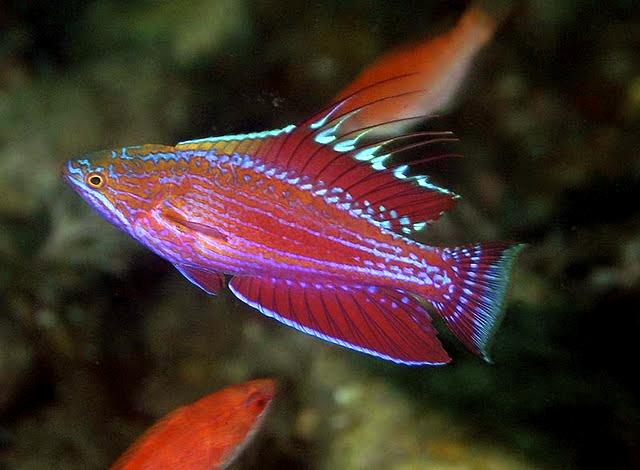

Pictured above is a really gorgeous hybrid between Paracheilinus togeanensis and P. filamentosus. While P. filamentosus is a staple and a widely known species in the trade, P. togeanensis (Togean flasher wrasse)is not. The Togean flasher wrasse is a species that has never entered the aquarium trade before, and is not well known even amongst wrasse aficionados.
Found in Sulawesi and Togean Islands, the fish looks just like any other member of the Paracheilinus genus, except for the large rounded dorsal fin with the absence of any filaments. The large dorsal fin is really beautiful and starts curving exponentially as it progresses toward the posterior.
Like many other flasher wrasses documented in the Indo-Pacific region, it overlaps in range with many congeners and often hybridizes with them. P. filamentosus, P. flavianalis and P. cyaneus have all been documented to hybridise with the Togean flasher wrasse.

Identifying flasher wrasse hybrids can be difficult and taxing, since most of them have wildly similar body colors and patterns, with only the unpaired fins to differentiate the species. P. togeanensis is not very well known because of the lack of pictures and information online.
Here are some really good pictures featuring them in the wild, in Lembeh Straits. As with all members of the genus, the flasher wrasses are haremic and males flash their colors to attract potential females. Nuptial coloration often involve brilliant metallic shades of blue and white, as well as a general increase in color intensity. Below is another photo of a hybrid between P. togeanensis and possibly P. flavianalis or P. filamentosus.


The left side photo is a typical appearance of flasher wrasse displaying. When courting females or displaying to rival males, Paracheilinus wrasses display their nuptial coloration, or “flash”. This flashing behavior is accompanied by rapid swimming movements as well as the flaring of all fins. The most notable change is the intensification of colors and the appearance of metallic blue hues.
Check out the flashing hybrid on the left. Notice the intense metallic blue sheen that develops on the dorsal region of the body as well as on the fins. The blue lines on the body also pick up the metallic change and meanders through the fish. The fairy wrasses of the genus Cirrhilabrus also display in a similar fashion, but are often not as metallic as their flasher wrasse cousins.
This rarely seen hybrid is just an example of what these flasher wrasses are capable of producing in the wild. Unlike fairy wrasses, the flasher wrasses are messy spawners and often spawn with females of different species. Almost all female flasher wrasses are indistinguishable from each other and often mix around in large inter-species harems.

Hybrids therefore, are not uncommon in flasher wrasses but are extremely uncommon in fairy wrasses. Other notable hybrids are those involving Paracheilinus angulatus. Hybrids with the unique P. angulatus are stunning as well, due to the unique cursor like finnage of P. angulatus.




